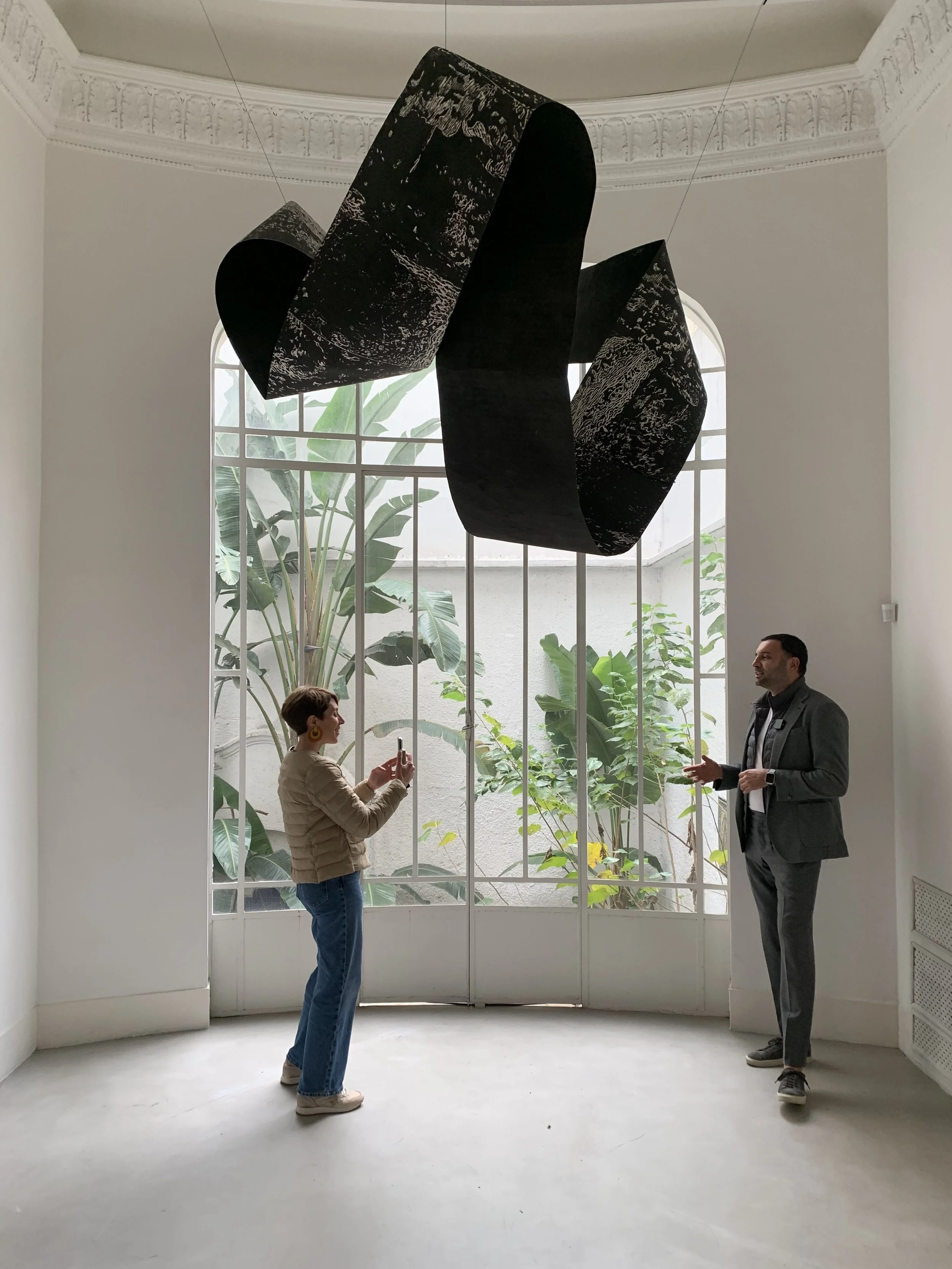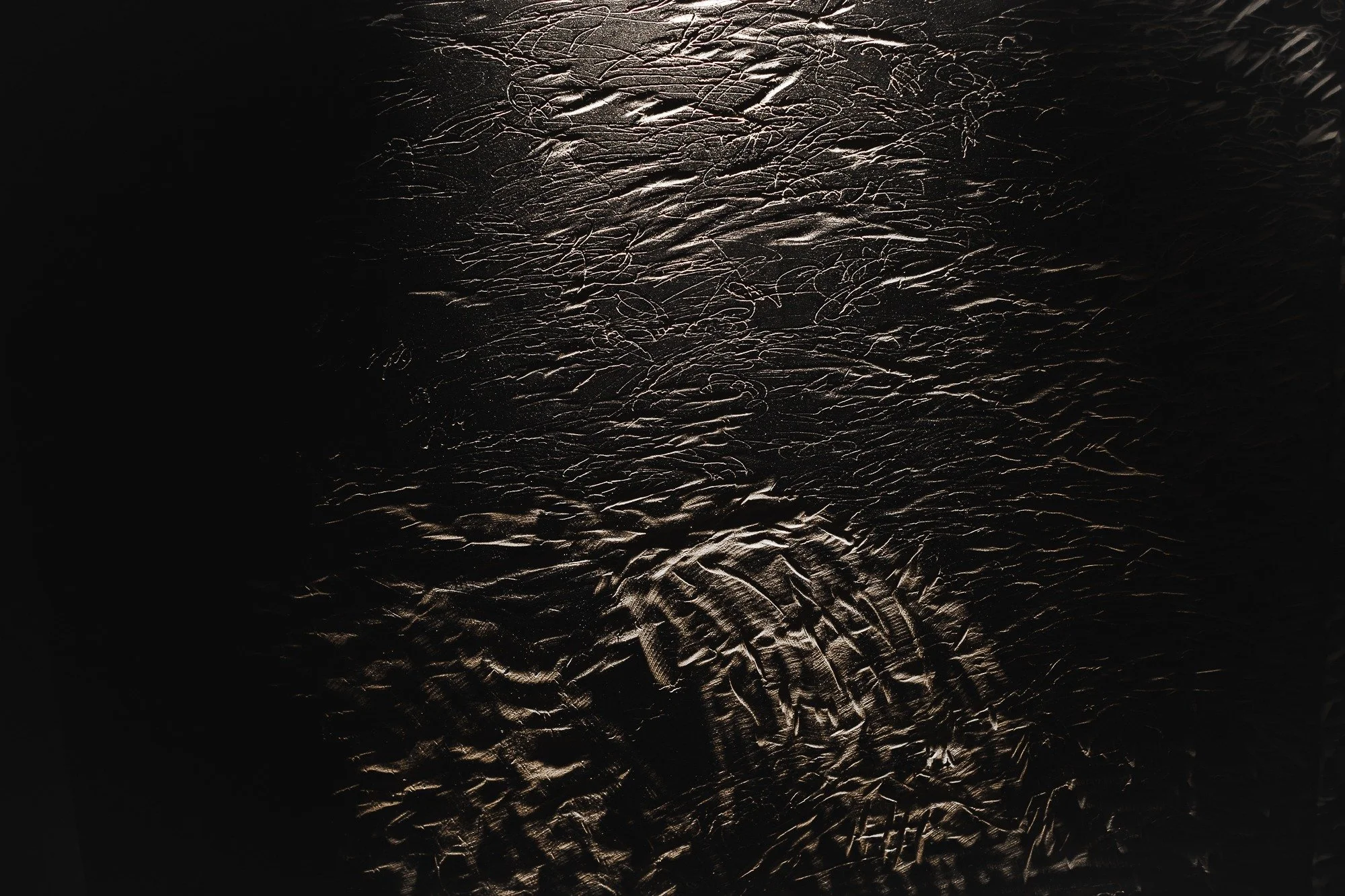Incisive Impressions: Decoding Julián Pesce. Art of transformation and technique
Incisive Impressions: Decoding Julián Pesce. Art of transformation and technique.
COLECCIÓN MAG:
Tell us what you're doing in the studio.
Julián Pesce:
Alright. Well, let's see, where do we start? Here I'm working on a series of large-format engravings. Graphic arts are an excuse, let's say, to multiply the image and create installations. I'm working site-specifically, thinking about the production around the exhibition spaces, for example, the solo show at La Galerilla in Pueblo Garzón, Uruguay, which was designed to be experienced inside a train car, which isn't a very conventional place to exhibit.
There, I created a series of wood matrices. For those unfamiliar with woodcut (xilography), it's a printing technique where you use a rigid plate to engrave it by removing material, and from that, you can make prints on both fabric and paper. You ink the matrix, run it through a press, apply pressure, and you can repeat the image.
In Uruguay, I exhibited the wood plates, which, when arranged together, form an "S" when viewed from above – a sum of segments forming a double curve. Months later, all the fabric prints were exhibited at Museo Mar, Mar del Plata. It's a work that keeps evolving, it's self-feeding, it can grow in scale and take on different formats.
COLECCIÓN MAG:
And what's the process like working with the matrices? How did you get into that?
Julián Pesce:
These plates are worked on both sides. On one side, it's a tribute to Richard Serra, the American sculptor who passed away recently. He has large industrial-scale installations; I was particularly interested when I was at the Guggenheim in Bilbao. He was one of the artists who impacted me the most. He worked with Cor-Ten steel, which is a very special steel due to its durability, making it perfect for outdoors.
In the room next to the installation, there are models and information about the production process; there he presents a series of geometric bodies that he used to construct curves in his large installations. I took those figures to represent them in this engraving technique.
On their reverse, the plates show a 9-meter landscape that I've been revisiting for a long time, a place I used to visit with my family, with my mom, Mariana Schapiro, who was also a sculptor. She did a series of works related to this place in southern Chile. Twenty years later, I'm revisiting this landscape, making my own version. It's an image worked with power tools, a relief that can be printed but also functions as an installation, as a graphic object.
In traditional woodcut, gouges or knives are used, but I work with an angle grinder and lathes. I make my own metal tips with nails or drill bits that I then cut to achieve different strokes and textures.
COLECCIÓN MAG:
And how do you manage to represent that landscape?
Julián Pesce:
It's between the abstract and the figurative; I'm not so interested in mimetic representation. I use power tools because they have a speed that's between control and lack of control. The machine exerts a lot of pressure, so if you don't hold it firmly, it gets away from you. I play with that, with a design that's controlled but also leaves room for the unpredictable, creating a very interesting richness.
COLECCIÓN MAG:
Incredible! How did you end up exhibiting in Bilbao?
Julián Pesce:
I won an award, the Open Buenos Aires in August 2022, for a residency in the Basque Country, Bilbao, at a biodesign center, the Basque Bio Design Center. It was interesting because, living in Argentina, sometimes there are limitations in terms of both budget and materials. The space they offered me there had many facilities, with good equipment and excellent professionals. I worked with the historical archive of Industrial Bilbao, exploring how the city radically transformed towards a proposal centered on design – architectural, artistic, and sustainable – now considered a green city.
COLECCIÓN MAG:
And what did you do with the historical archive?
Julián Pesce:
I took images from the archive, of the workers in the boilers, of the gray city marked by the soot of the iron and steel industry, mining, the large furnaces. The idea was to condense into images a meeting between the old city and the new sustainable urban proposal, a temporal crossroads where traces of coexistence still remain, also taking images of old chimneys and industrial ruins.
I printed this combination of historical archive and current documentation with screen printing on biomaterials that we cooked in the laboratory, like bioplastics made with gelatin or alginate, which are under development, using them as a support. I also used charcoal. I worked on these very delicate materials that have a limited life, which questions the idea of art as something permanent. It's a more ephemeral work, and that fascinates me.
COLECCIÓN MAG:
And what are you preparing now?
Julián Pesce:
Now I'm preparing an exhibition for the Legislature of the City of Buenos Aires. They're going to give me a declaration of interest for my work. It's a very beautiful, circular hall with a dome, so the geometric figures of my plates will resonate with that space. Since nothing can be drilled, I'm going to exhibit eight wooden plates on self-supporting stands, and on the opposite side, there will be prints on fabric in blue tones.
COLECCIÓN MAG:
Are you going to make a definitive change in your work with these biomaterials?
Julián Pesce:
I like to change. Graphic arts are very versatile, but also laborious. Woodcut is a technique that, while it uses eco-friendly inks, is still a bit toxic. I'm interested in exploring more sustainable materials, but I also have series of small color watercolors, and I like to vary my proposals. I think a balance between visual identity and not repeating oneself is essential in an artist's career.
COLECCIÓN MAG:
What future projects do you have?
Julián Pesce:
In the second half of 2025, I'm going to be doing a production residency in Shanghai, sponsored by Swatch, a company that has been committed to supporting artists for several decades. There, I want to explore the use of different papers. China created paper XIII centuries before it reached Europe. My proposal is to create Chinese landscapes with ancient techniques, and I believe I'll find many interesting connections there. I'm also interested in continuing to develop large works, like installations, which generate a very special impact on viewers.
COLECCIÓN MAG:
How exciting! I wish you much success in everything.
Julián Pesce:
Likewise! Thanks for this space.
ARTIST BIO
Julián Pesce was born in Buenos Aires, Argentina, where he lives and works. He holds a BA in Electronic Arts from UNTREF.
He has been declared a Distinguished Personality and his work of Cultural Interest by the Legislature of the City of Buenos Aires.
His work has been included in Volume XIII of the General History of Argentine Art by the National Academy of Fine Arts.
He was awarded the OPENBA prize for a research and production residency at the Basque Bio Design Center in the Basque Country. The work created there was exhibited during the Professional Art Week in Oviedo, Spain.
2023, he held his fourth solo exhibition in Kakheti, Georgia. He was a guest of honor at the Boyacá International Culture Festival in Colombia, where he gave graphic arts workshops in Medellín.
2024, he opened "Sierra," a solo exhibition in Pueblo Garzón, Maldonado, Uruguay. He also exhibited at Museo Mar, Mar del Plata, Buenos Aires province.
In 2025, Pesce will be awarded a research and production fellowship in Shanghai, China.




